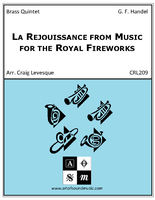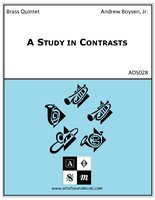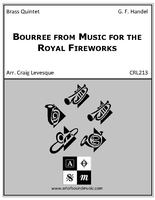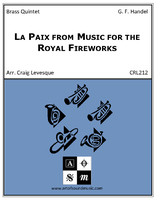Solemn Entry of the Knights of the Order of St. John
| Arranger | Olson, Gary |
|---|---|
| Composer | Strauss, Richard |
| Duration | 6 |
| Ensemble | Brass Quintet and Organ |
| Genre | Classical |
| Grade | 4 |
| Model Number | DBP0136 |
| Category | Brass Quintet - All, Brass Quintet and Organ |
Although military and ceremonial music did not often inspire Richard Strauss, as Germany’s leading composer, he was, on occasion, called on for such music. Feierlicher Einzug, dedicated to the Knights of the Order of St. John and composed in 1909, was one such piece. This piece was originally scored for fifteen trumpets, four horns, four trombones, two tubas and timpani. Strauss thought enough of the piece to rescore it for full symphony orchestra with organ. Max Reger prepared and published an organ condensation. The current arrangement for brass quintet with organ is based on the original brass version and the Reger condensation and is dedicated to E. Power Biggs, whose contribution to the medium of organ and brass was immense. It was his suggestion that led Canzona Publications to prepare new arrangements for brass quintet and organ of much of the music on his rescore, “Music for Organ, Brass, and Percussion.”
The “Knights Hospitaller”, also known as the Knights of Saint John were among the most famous of the Western Christian military orders during the Middle Ages. Strauss wrote this in 1909 at the express wish of the Kaiser. The piece was originally for 12 trumpets, 3 solo trumpets, 4 horns, 4 trombones, 2 tubas and timpani. In this treatment the brass is scaled back to a standard quintet and all other parts covered by organ. During the time of the First Crusade, the Benedictines, directed by Gerard, maintained a hospice for pilgrims to the Holy City, named in honor of St. John. When the crusaders surrounded the Jerusalem in 1099, Gerard played an active role in the subsequent capture of that city. He then established an Order of Hospitallers to serve and minister to pilgrims, and became the Order’s first Grand Master. In 1113, Pope Paschal II took the hospitallers under his immediate protection. Although the Order may have undertaken the armed defense of pilgrims at the time, its role centered around the hospice. The second Grand Master of the Order of St. John, Raymond duPue, assumed the leadership in 1120 and molded the group into an aggressive military force. The Order accepted the newly fortified castle at Bait Jibrin in 1137, and as the feudal lords of Syria became impoverished, took over increasing numbers of fortifications. At the same time, the Order received increased papal privileges and became universal in scope, branches and possessions and most of the European states. With the decline of feudalism and their increase in religious and military power, the Knights of St. John became a potent military force in the Holy Lands. The Knights played a significant role in all of the subsequent crusades and were important in all major attacks made on the Muslims in the Thirteenth Century, often sparing neither men nor resources to keep the Muslims at bay.
In the late Thirteenth Century, the Infidels got the upper hand and the Knights are finally expelled from Syria. Headquarters of the Hospitallers were moved to Cyprus. In 1309, under the leadership of Grand Master Guillaume deVillaret, the Knights captured the island of Rhodes from the Byzantines. Thus, the Knights became a sovereign power. Because of the location of Rhodes as an important trading hub between Europe and the East, the Knights developed a navy. The Order increased in possessions and wealth, and with the suppression of the Templars in 1312, the Order received what remained of their vast holdings. Always ready to support a major attack on Muslims, the Knights were themselves frequently subject to attack. They showed courage and military skill in defending their island home, and became the best training school of military and naval warfare in Europe. They successfully repelled Egyptian attacks in 1440 and 1444, and in 1480 held at bay the Ottoman fleet and army. In 1522, they were attacked by Sulliman the Magnificent but received no support from the Christian princes of Europe who were too busy fighting with each other. Although led by one of their most effective Grand Masters, L’Isle-Adam, they were driven from Rhodes and took refuge in Crete. The presence of the Knights in Rhodes delayed for two hundred years the appearance of the Ottomans as a naval power in the Mediterranean.
The island of Malta was granted to them by Charles V in the early fifteen hundreds, a time contemporaneous with the Reformation. At the same time, Henry VIII confiscated the estates and property of the Knights in England and effectively abolished that branch of the Order. Nonetheless, the Knights continued their vigorous warfare against the Turks and other Infidels. On May 18, 1565, an Ottoman fleet appeared on the horizon and laid siege to the island of Malta. Although vastly outnumbered, the Knights, led by Grand Master Jean Parriot de laVallente, killed over twenty-five thousand of the enemy before the siege was raised by a large Spanish relief force. During this time, the Order increased enormously in wealth through commerce, the spoils of war, and financial support from their European branches. They built elaborate fortifications, chapels, churches, and established a great library at Malto. They continued to maintain their prestige by naval victories over the Turks. By the late seventeen hundreds, the various Infidels to the east were much less of a threat, and military prowess was thus eroded. The famous galleys were no longer effective fighting ships, but were used primarily for ceremonial purposes. In 1892, the vast possessions of the French Division of the Order were appropriated by Napoleon, who then occupied their island in 1798 on the way to Egypt. Little resistance was organized by the ineffective Grand Master, Ferdinand Hompesh.
Driven from Malta, the Knights were no longer a sovereign power, and the military aspects of their order became superfluous. They reverted to their initial role as hospitallers, a role which they had maintained simultaneously with their military service throughout the centuries. The German portion of the Order became Protestant and thus split from the main group. An attempt was made to re-establish the English side of the Order in 1831 when Sir Robert Peat became Prior of the Venerable Tongue of England. The English branch declared itself an independent Order in 1858 when headquarters in Rome would not accept a Protestant division of the Order. In 1875, the English group acquired the site and remains of the Priory at Clerkenwell, which had served the Knights as headquarters in the Twelfth Century. The English branch of the Order distinguished itself by outstanding medical work in the two World Wars.
During the height of power of the Knights of St. John, the Order was made up of three classes of people: Knights, Chaplains and Serving Brothers, the Knights, of course, were dominant. Knights were drawn from the aristocracy. Candidates had to undergo a formal presentation of proofs which usually required the most severe investigation and had the appearance of an inquisition. Family secrets were ransacked to make sure that no heretical beliefs stained any relative, that no one in the family had omitted indiscretions producing illegitimate children, and that the family was not defiled by a vile or dishonoring trade. To become and Knight required significant financial resources as well. Although strict membership requirements were, at times, corrupt, the price paid by these candidates seems an extreme price for the privilege of killing off Moors, Turks, Arabs, and other Infidels.









